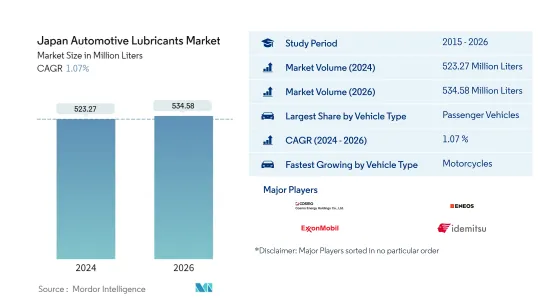
|
市場調査レポート
商品コード
1430689
日本の自動車用潤滑油:市場シェア分析、産業動向と統計、成長予測(2021年~2026年)Japan Automotive Lubricants - Market Share Analysis, Industry Trends & Statistics, Growth Forecasts (2021 - 2026) |
||||||
カスタマイズ可能
適宜更新あり
|
|||||||
| 日本の自動車用潤滑油:市場シェア分析、産業動向と統計、成長予測(2021年~2026年) |
|
出版日: 2024年02月15日
発行: Mordor Intelligence
ページ情報: 英文 80 Pages
納期: 2~3営業日
|
全表示
- 概要
- 目次
日本の自動車用潤滑油市場規模は2024年に5億2,327万リットルと推定・予測され、2026年には5億3,458万リットルに達し、予測期間中(2024年~2026年)のCAGRは1.07%で成長すると予測されます。

主なハイライト
- 車両タイプ別最大セグメント-乗用車:日本は乗用車の保有台数が多いです。その結果、日本の自動車用潤滑油業界では、この分野の潤滑油消費が最も高いシェアを占めています。
- 自動車タイプ別最速セグメント-二輪車:2021年以降、日本における二輪車の生産と販売の回復が加速すると予想されます。その結果、潤滑油の消費成長率は高くなると予想されます。
- 製品タイプ別最大セグメント-エンジンオイル:エンジンオイルは、高温・高圧用途に使用されるため、必要量が多く、ドレイン間隔が短いことから、製品タイプ別ではトップです。
- 製品タイプ別最速セグメント:油圧作動油:2021年以降、日本における自動車販売と生産の回復が見込まれることから、予測期間中、日本における油圧作動油の需要を牽引すると予測されます。
日本の自動車用潤滑油市場動向
車両タイプ別最大セグメント:乗用車
- 日本では、2020年のオンロード車総数に占める乗用車(PV)のシェアが71.38%と最も高く、商用車(CV)が16.72%、二輪車が11.9%と続く。
- 2020年の潤滑油総消費量に占める割合は、乗用車が49.43%と最も高く、商用車(48.3%)、二輪車(2.27%)がそれぞれこれに続く。2020年には、COVID-19の発生によって潤滑油消費量の落ち込みが顕著になり、PVの潤滑油消費量が13.1%と最も高い落ち込みを記録し、続いて商用車(12.28%)となった。
- 二輪車セグメントは、2021~2026年のCAGRが2.72%で、最も急成長する潤滑油消費者になると予測されます。この成長は、国内におけるパーソナルモビリティと電気自動車の生産台数の増加が見込まれることに牽引されると予測されます。
日本の自動車用潤滑油産業の概要
日本の自動車用潤滑油市場はかなり統合されており、上位5社で93.83%を占めています。この市場の主要企業は、Cosmo Energy Holdings Co. Ltd, ENEOS Corporation, ExxonMobil Corporation, Idemitsu Kosan Co. Ltd and Royal Dutch Shell Plc(アルファベット順)です。
その他の特典
- エクセル形式の市場予測(ME)シート
- 3ヶ月間のアナリスト・サポート
目次
第1章 エグゼクティブサマリーと主な調査結果
第2章 イントロダクション
- 調査の前提条件と市場定義
- 調査範囲
- 調査手法
第3章 主要産業動向
- 自動車業界の動向
- 規制の枠組み
- バリューチェーンと流通チャネル分析
第4章 市場セグメンテーション
- 自動車タイプ別
- 商用車
- 二輪車
- 乗用車
- 製品タイプ別
- エンジンオイル
- グリース
- 作動油
- トランスミッション&ギアオイル
第5章 競合情勢
- 主要な戦略動向
- 市場シェア分析
- 企業プロファイル
- AKT Japan Co. Ltd(TAKUMI Motor Oil)
- BP PLC(Castrol)
- Cosmo Energy Holdings Co. Ltd
- ENEOS Corporation
- ExxonMobil Corporation
- FUCHS
- Idemitsu Kosan Co. Ltd
- Japan Sun Oil Company Ltd(SUNOCO Inc.)
- Motul
- Royal Dutch Shell Plc
第6章 付録
- 付録1参考文献
- 付録2図表一覧
第7章 CEOへの主な戦略的質問
The Japan Automotive Lubricants Market size is estimated at 523.27 Million Liters in 2024, and is expected to reach 534.58 Million Liters by 2026, growing at a CAGR of 1.07% during the forecast period (2024-2026).

Key Highlights
- Largest Segment by Vehicle Type - Passenger Vehicles : Japan has a large active passenger vehicle parc. As a result, the lubricant consumption of this sector occupies the highest share in Japan's automotive lubricant industry.
- Fastest Segment by Vehicle Type - Motorcycles : The recovery of motorcycle production and sales in Japan from 2021 is expected to be at a faster rate. As a result, its lubricant consumption growth rate is likely to be high.
- Largest Segment by Product Type - Engine Oils : Engine oil is the leading product type due to its high volume requirements and shorter drain intervals, as it is used for high-temperature and high-pressure applications.
- Fastest Segment by Product Type - Hydraulic Fluids : The expected recovery of automotive sales and production in Japan from 2021 is anticipated to drive the demand for hydraulic fluids in the country during the forecast period.
Japan Automotive Lubricants Market Trends
Largest Segment By Vehicle Type : Passenger Vehicles
- In Japan, passenger vehicles (PVs) accounted for the largest share, 71.38%, in the total number of on-road vehicles in 2020, followed by commercial vehicles (CVs) and motorcycles, with a share of 16.72% and 11.9%, respectively.
- Passenger vehicles accounted for the highest share of 49.43% in the total lubricant consumption in 2020, followed by commercial vehicles (48.3%) and motorcycles (2.27%), respectively. In 2020, the COVID-19 outbreak led to a notable dip in lubricant consumption, where PV lubricant consumption recorded the highest dip of 13.1%, followed by commercial vehicles (12.28%).
- The motorcycles segment is projected to be the fastest-growing lubricant consumer, with a CAGR of 2.72% during 2021-2026. The growth is projected to be driven by an expected rise in personal mobility and electric vehicle production in the country.
Japan Automotive Lubricants Industry Overview
The Japan Automotive Lubricants Market is fairly consolidated, with the top five companies occupying 93.83%. The major players in this market are Cosmo Energy Holdings Co. Ltd, ENEOS Corporation, ExxonMobil Corporation, Idemitsu Kosan Co. Ltd and Royal Dutch Shell Plc (sorted alphabetically).
Additional Benefits:
- The market estimate (ME) sheet in Excel format
- 3 months of analyst support
TABLE OF CONTENTS
1 Executive Summary & Key Findings
2 Introduction
- 2.1 Study Assumptions & Market Definition
- 2.2 Scope of the Study
- 2.3 Research Methodology
3 Key Industry Trends
- 3.1 Automotive Industry Trends
- 3.2 Regulatory Framework
- 3.3 Value Chain & Distribution Channel Analysis
4 Market Segmentation
- 4.1 By Vehicle Type
- 4.1.1 Commercial Vehicles
- 4.1.2 Motorcycles
- 4.1.3 Passenger Vehicles
- 4.2 By Product Type
- 4.2.1 Engine Oils
- 4.2.2 Greases
- 4.2.3 Hydraulic Fluids
- 4.2.4 Transmission & Gear Oils
5 Competitive Landscape
- 5.1 Key Strategic Moves
- 5.2 Market Share Analysis
- 5.3 Company Profiles
- 5.3.1 AKT Japan Co. Ltd (TAKUMI Motor Oil)
- 5.3.2 BP PLC (Castrol)
- 5.3.3 Cosmo Energy Holdings Co. Ltd
- 5.3.4 ENEOS Corporation
- 5.3.5 ExxonMobil Corporation
- 5.3.6 FUCHS
- 5.3.7 Idemitsu Kosan Co. Ltd
- 5.3.8 Japan Sun Oil Company Ltd (SUNOCO Inc.)
- 5.3.9 Motul
- 5.3.10 Royal Dutch Shell Plc
6 Appendix
- 6.1 Appendix-1 References
- 6.2 Appendix-2 List of Tables & Figures

